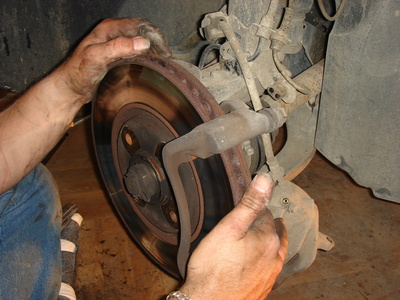
Automobile manufacturers incorporate the emergency brake into the rear brakes of their vehicles in several different ways. Lower-cost cars often use drum brakes in the rear position, in which case the drum brake can also be used as the emergency brake. When rear disc brakes are used, many manufacturers incorporate an emergency drum brake into the center of the rear brake rotor, while others integrate an emergency brake mechanism in the rear brake caliper. With this last type, it is necessary to screw the piston back into the brake cylinder when servicing the brake, rather than pushing it back in as with a normal brake caliper. Knowing the procedure for retracting this type of piston is helpful when servicing rear disc brakes.
Park the vehicle, and block the front wheels to prevent accidental vehicle rolling. Do not set the emergency brake. Partly loosen the lug nuts on the rear wheel to be serviced. Jack the car up, and set it securely on a safety (jack) stand. Finish removing the wheel.
Remove the two-caliper bolts, and lift the caliper up and off the disc. Suspend the caliper from a convenient location using a bungee cord or wire hook. Take care not to kink or stretch the flexible brake hose.
Remove any retaining clips that hold the brake pads in place by prying them off with a screwdriver or pulling them off with pliers, as appropriate. Take care not to damage the clips, so they can be reused in reassembly. Remove the brake pads by sliding them toward the center of the caliper until they are released.
Retract the piston. This can be done in three ways. First, most manufacturers sell special tools for this function. Purchase the appropriate special tool at your auto dealer and follow the instructions that come with it. Second, purchase an aftermarket piston retracting tool at your local auto parts store or online. These aftermarket tools typically cost about a quarter of the price for the manufacturer's special tool, and work just as well. Most aftermarket tools come with a number of adapters to fit most piston faces. Third, hook a large C-clamp over the back of the caliper frame and tighten the spindle to put firm pressure on the piston face. Do not try to force the piston back into the cylinder. Grip the outside of the piston with large channel lock pliers, and rotate the piston clockwise to move it back into the cylinder. Tighten the C-clamp after every rotation of the piston in order to keep up the backward pressure. Take care not to twist or damage the rubber piston boot.
Follow the steps in reverse order to reassemble the brake. Replace the wheels, and lower the vehicle. Start the engine, and pump the brake pedal several times to extend the pistons, and reset the emergency brake adjuster. Test the brake operation before driving normally.